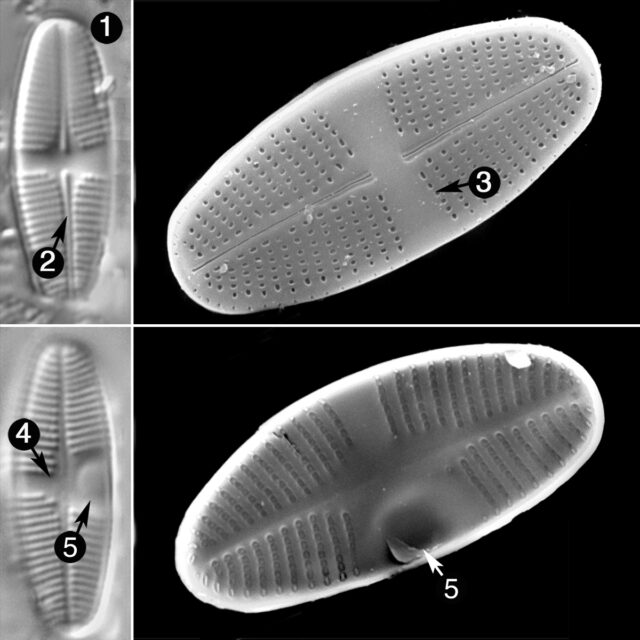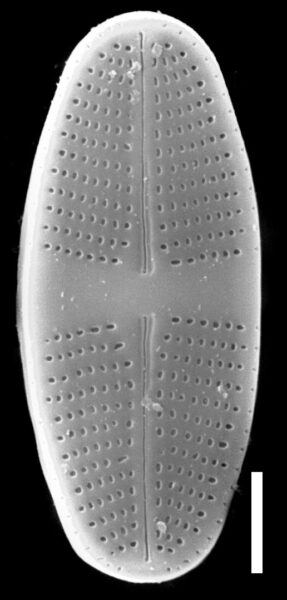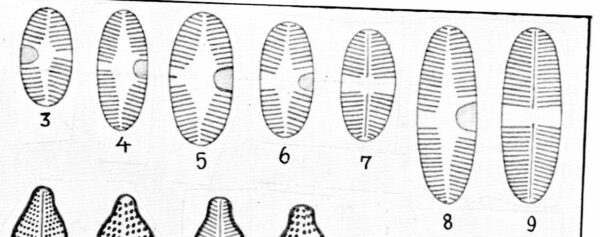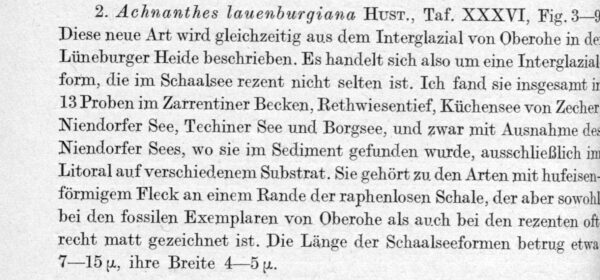Psammothidium lauenburgianum
-
Category
-
Length Range8.0–14.0 µm
-
Width Range3.5–5.0 µm
-
Striae in 10 µm24–28
-
ContributorPaul Hamilton, Marina Potapova - May 2010
-
ReviewerSarah Spaulding - Feb 2012
Identification
Description
Valves are elliptic to elliptic-lanceolate. The raphe valve has a linear axial area and a transversely rectangular, to bow-tie shaped central area, which is slightly asymmetric or symmetric. The raphe is straight and lacks terminal raphe fissures. The central and terminal raphe ends are simple. Internally, the central raphe ends curve toward opposite sides. The rapheless valve has a lanceolate axial area and a large, transverse, asymmetric central area with a rimmed depression on the internal valve surface. The striae are radiate on both valves. One row of areolae is present on the mantle of both valves. The external openings of the areolae are mostly isodiametric.
Original Description
Diese neue Art wird gleichzeitig aus dem Interglazial von Oberohe in der Lüneburger Heide beschrieben. Es handelt sich also um eine Interglazialform, die im Schaalsee rezent nicht selten ist. Ich fand sie insgesamt in 13 Proben im Zarrentiner Becken, Rethwiesentief, Küchensee von Zecher, Niendorfer See, Techiner See und Borgsee, und zwar mit Ausnahme des Niendorfer Sees, wo sie im Sediment gefunden wurde, ausschlieβlich im Litoral auf verschiedenem Substrat. Sie gehört zu den Arten mit hufeisen-förmigem Fleck an einem Rande der raphenlosen Schale, der aber sowohl bei den fossilen Exemplaren von Oberohe als auch bei den rezenten oft recht matt gezeichnet ist. Die Länge der Schaalseeformen betrug etwa 7–15 μ, ihre Breite 4–5 μ.
-
BasionymAchnanthes lauenburgiana
-
AuthorHust. 1950
-
Length Range7–15 µm
-
Width4–5 µm
Citations & Links
Citations
-
Publication Link: 10.1080/0269249X.1996.9705361
Cite This Page
Hamilton, P., Potapova, M. (2010). Psammothidium lauenburgianum. In Diatoms of North America. Retrieved July 26, 2024, from https://diatoms.org/species/psammothidium_lauenburgianum
Responses
The 15 response plots show an environmental variable (x axis) against the relative abundance (y axis) of Psammothidium lauenburgianum from all the stream reaches where it was present. Note that the relative abundance scale is the same on each plot. Explanation of each environmental variable and units are as follows:
ELEVATION = stream reach elevation (meters)
STRAHLER = distribution plot of the Strahler Stream Order
SLOPE = stream reach gradient (degrees)
W1_HALL = an index that is a measure of streamside (riparian) human activity that ranges from 0 - 10, with a value of 0 indicating of minimal disturbance to a value of 10 indicating severe disturbance.
PHSTVL = pH measured in a sealed syringe sample (pH units)
log_COND = log concentration of specific conductivity (µS/cm)
log_PTL = log concentration of total phosphorus (µg/L)
log_NO3 = log concentration of nitrate (µeq/L)
log_DOC = log concentration of dissolved organic carbon (mg/L)
log_SIO2 = log concentration of silicon (mg/L)
log_NA = log concentration of sodium (µeq/L)
log_HCO3 = log concentration of the bicarbonate ion (µeq/L)
EMBED = percent of the stream substrate that is embedded by sand and fine sediment
log_TURBIDITY = log of turbidity, a measure of cloudiness of water, in nephelometric turbidity units (NTU).
DISTOT = an index of total human disturbance in the watershed that ranges from 1 - 100, with a value of 0 indicating of minimal disturbance to a value of 100 indicating severe disturbance.

Psammothidium lauenburgianum
- Valves are elliptic to elliptic-lanceolate
- Raphe straight
- Central area on raphe valve transversely rectangular to bow-tie shaped, symmetric or slightly asymmetric
- Central area on rapheless valve asymmetric, containing rimmed depression
Valves are elliptic to elliptic-lanceolate. The raphe valve has linear axial area and transversely rectangular to bow-tie shaped central area, which is slightly asymmetric or symmetric. The rapheless valve has a lanceolate axial area and a large, transverse, asymmetric central area with a rimmed depression on the internal valve surface....
 Diatoms of North America
Diatoms of North America











